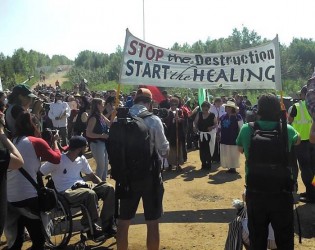Article Origin
Volume
Issue
Year
Organizers of the Healing Walk, which covers a section of the Alberta tar sands, will be shifting their focus next year.
“We’re not moving away from (campaigning against) open pit mining to focus on in situ…but we need to focus on other communities that are needing help,” said Jesse Cardinal, organizer of the Healing Walk and coordinator with Keepers of the Athabasca. “In situ is going to be surpassing open pit mining and there’s a lot of concerns and issues around that.”
Keepers of the Athabasca works closely with scientists, Cardinal says, who have expressed concerns regarding the technology being used for in situ development. Scientists say communities need to be made aware and the government held accountable.
Keepers of the Athabasca, and its allies, held the first Healing Walk five years ago. The last Healing Walk took place June 27-29, with approximately 300-500 people joining in on portions of the 14 km march past Syncrude and Suncor mines, tailings ponds, and upgraders in the Fort McMurray First Nation’s traditional land. Cardinal says over the three-day event, 1,000 people participated in the workshops, feast, prayers, and march, coming as far as Europe. There were people from the United States and across Canada as well as the local community.
“There is more and more interest in not only the science of it, but the spirituality of the Indigenous people and how that connection really is to the land,” said Cardinal.
“The walk calls forth to end the destruction of the land from tar sands expansion and to begin the healing. We came to show our solidarity with the communities who are most impacted,” blogged Pacific regional organizing assistant Brigette DePape of the Council of Canadians. She was one of a handful from her organization to attend.
It is that message of healing that Cardinal says is crucial: the walk has never been about protest. And that realization was underscored when local RCMP presented spiritual leaders of the fifth and final Healing Walk with tobacco.
“We highlight that connection of how we’re connected to the land, how (if) the land is hurting, how that in turn affects people, how that affects animals, how that affects water, how that affects the air. And we want to continue having those conversations… because we can’t go forward disconnected, focusing only on science, only on facts,” said Cardinal. “We want to continue highlighting that knowledge, learning that knowledge, sharing that knowledge of how (the First People) stewarded the land, how they’re still stewarding the land.”
Those conversations will now be hosted by communities, which are impacted by rapid industry development on their traditional lands. The annual event could take the form of cultural camps or workshops.
While no community has been chosen for next year, Cardinal says talks are occurring with Beaver Lake First Nation, which, along with Cold Lake First Nation, has been impacted by the multiple emulsion-to-surface releases of a CNRL operation on the Cold Lake Weapons Range. There remains concern among First Nations and environmental groups that the situation, which was made public July 2013, has not been adequately addressed.
Cardinal says discussions are also taking place with Big Stone Cree First Nation and First Nations in the Peace River region, who have called upon Keepers of the Athabasca for help.
Keepers of the Athabasca is not opposed to organizing another Healing Walk in the future, says Cardinal.
Photo caption: Between 300-500 people marched portions of 14 km that showed the impact of tarsands development on Fort McMurray First Nation’s traditional land.
- 1084 views

